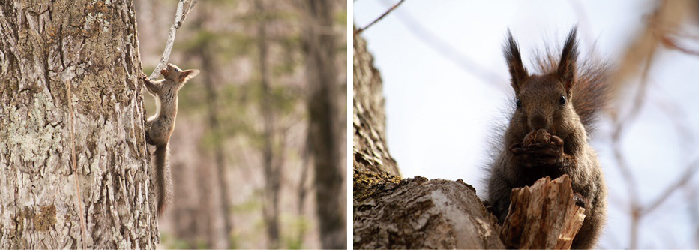Quietly, I watched a Sciurus vulgaris orientis eating a walnut. It seemed to be enjoying it very much.
First the squirrel found the walnut and then took it to a safe place (left photo). Then it gnawed on the walnut with a “gaji-gaji” sound along the line to break it in two from the center (center photo).
When the walnut cracked after a few minutes, the squirrel held it so it wouldn’t fall and ate one side at a time (right photo).
However, when a walnut cracks open completely, one half usually falls to the ground. Thus, after eating one half, the squirrel must go down to retrieve it and begin the process again from the step shown in the left-hand photo.
Yet these squirrels are smart. Sometimes they don’t open the walnut open all the way, but only apply enough pressure to crack it (in this case, the cracked side does stays attached to the bottom of the walnut). This way they can eat both sides together.
The squirrel I was watching scampered off into the forest the moment it finished eating.
Photos: A feeding Sciurus vulgaris orientis in Sounkyo Apr. 30
First the squirrel found the walnut and then took it to a safe place (left photo). Then it gnawed on the walnut with a “gaji-gaji” sound along the line to break it in two from the center (center photo).
When the walnut cracked after a few minutes, the squirrel held it so it wouldn’t fall and ate one side at a time (right photo).
However, when a walnut cracks open completely, one half usually falls to the ground. Thus, after eating one half, the squirrel must go down to retrieve it and begin the process again from the step shown in the left-hand photo.
Yet these squirrels are smart. Sometimes they don’t open the walnut open all the way, but only apply enough pressure to crack it (in this case, the cracked side does stays attached to the bottom of the walnut). This way they can eat both sides together.
The squirrel I was watching scampered off into the forest the moment it finished eating.
Photos: A feeding Sciurus vulgaris orientis in Sounkyo Apr. 30

